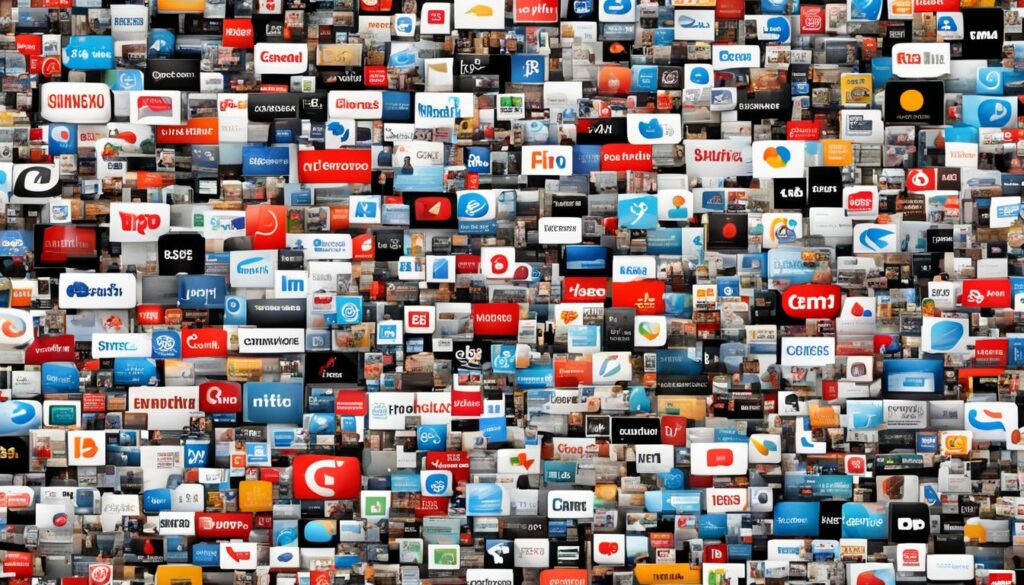Integrated marketing communications (IMC) is revolutionizing the way marketers approach advertising. In today’s competitive landscape, a fragmented marketing strategy is no longer effective. Marketers are realizing the power of integrating all marketing channels and messages into one cohesive and strategic approach.
So, why are marketers taking an IMC perspective to their advertising? The answer lies in the effectiveness and impact that integrated marketing campaigns can have on a brand’s success. By breaking down the silos between departments and aligning all marketing efforts, IMC ensures a seamless brand experience for consumers.
Not only does IMC foster brand consistency, but it also allows marketers to reach larger audiences. By utilizing multiple channels to communicate with different segments of their target market, businesses can broaden their reach and increase their chances of engaging with consumers.
This shift towards IMC is driven by the desire for greater campaign synergy and the need to create impactful brand messaging. By leveraging the strengths of each marketing channel and delivering a unified message, marketers can maximize the effectiveness of their advertising efforts.
Key Takeaways:
- Integrated marketing communications (IMC) offers a strategic and holistic approach to advertising.
- IMC ensures a unified and seamless brand experience for consumers.
- An IMC approach builds brand recognition, trust, and reaches larger audiences.
- Integrated marketing communications examples showcase the power of integrated messaging across various channels.
- The importance of IMC lies in fostering brand consistency, reaching larger audiences, and generating higher revenues.
The Benefits of Integrated Marketing Communications
An integrated marketing communications (IMC) approach offers several key benefits for marketers. By leveraging the power of marketing communication, businesses can enhance brand recognition, reach larger audiences, and ultimately achieve higher revenues.
Brand Recognition and Trust: By consistently delivering a cohesive brand message across multiple channels, IMC helps build brand recognition and trust among consumers. This integrated approach ensures that the brand’s values and identity are effectively communicated, enabling consumers to easily recognize and trust the brand. Consequently, consumers are more likely to engage with the brand, leading to increased sales and loyalty.
Reach Larger Audiences: IMC allows marketers to connect with different segments of their target market by utilizing multiple channels. Through integrated marketing campaigns, businesses can engage with a diverse audience across various platforms such as TV, radio, print media, social media, and more. This broader reach enables businesses to tap into new markets, attract new customers, and expand their customer base, ultimately driving higher revenues.
As a result, IMC plays a crucial role in helping businesses effectively communicate their brand message, engage consumers, and generate substantial returns on their marketing investments.
To illustrate the effectiveness of IMC, consider the following example:
“Our brand is able to effectively reach and engage our target audience by implementing an integrated marketing communications strategy. By combining TV commercials, social media campaigns, and online advertising, we have witnessed a significant increase in brand recognition, customer engagement, and ultimately, higher revenues.” – Marketing Director, XYZ Company
To further emphasize the benefits of IMC, below is a visual representation of the impact of integrated marketing communications:
| Benefits of Integrated Marketing Communications | Impact |
|---|---|
| Enhanced brand recognition | Increase in brand awareness and recall |
| Expanded reach | Access to larger audience segments and new markets |
| Higher revenues | Increase in sales and customer acquisition |
https://www.youtube.com/watch?v=m_C6boP5m9U
By adopting an integrated marketing communications approach, businesses can harness the power of marketing communication to effectively build brand recognition, connect with larger audiences, and drive higher revenues.
Integrated Marketing Communications Examples
Integrated marketing communications is best illustrated through examples. One notable example is the successful IMC campaign by the feminine care products brand Always, titled #LikeAGirl.
The #LikeAGirl campaign showcased the power of integrated messaging across various channels, demonstrating the effectiveness of an integrated marketing approach. Always leveraged market research insights to create a powerful message about female empowerment. By utilizing social media, advertising, public relations, and other communication tools, the brand achieved remarkable success and increased brand effectiveness.
“Through our research, we discovered that at puberty, girls’ confidence plummets. Our ‘Like a Girl’ campaign sets out to change that, turning the phrase ‘like a girl’ from an insult to a celebration and reinforcing the message that girls can do anything. By embracing integrated marketing communications, we were able to amplify this message and reach a wider audience, creating a positive impact on girls’ self-esteem and societal perceptions.”
An integrated marketing communications strategy allowed Always to effectively communicate their empowering message and engage with their target audience. By breaking down traditional silos and incorporating social media, advertising, and public relations, Always was able to make a significant impact and achieve their campaign objectives.

This example demonstrates the effectiveness of integrated marketing communications in creating a cohesive and impactful advertising campaign. By leveraging multiple channels and tools, brands can amplify their message to a broader audience and achieve greater brand effectiveness.
The Importance of Integrated Marketing Communications
The integration of marketing communications plays a crucial role in modern business strategies. It is essential for fostering brand consistency, reaching larger audiences, and generating higher revenues. By aligning all marketing channels and messages, businesses can deliver a consistent brand experience, leading to increased recognition and trust.
Brand consistency is a key element in building a strong and memorable brand. When all marketing channels work together seamlessly, the brand’s messaging becomes more cohesive and impactful, creating a unified brand identity across various touchpoints. This consistent and recognizable brand image helps establish trust with consumers, making them more likely to engage with the brand and make purchasing decisions.
Furthermore, an integrated marketing communications approach allows businesses to reach larger audiences. By utilizing multiple channels, such as social media, email marketing, advertising, and public relations, marketers can connect with different segments of their target market and increase their overall reach. This broader reach amplifies brand exposure, attracting more potential customers and ultimately leading to higher revenues.
“Integrated marketing communications is like conducting an orchestra, where each instrument plays a vital role in creating a harmonious and impactful performance.”
For example, let’s consider a clothing brand that implements an integrated marketing communications strategy. Through social media platforms, they engage with younger demographics, showcasing their latest trends and promotions. Simultaneously, they run television and print advertisements to reach older audiences. By leveraging different channels to communicate with specific segments of their target market, they reach a wider audience and increase the chances of converting leads into paying customers.
An integrated approach to marketing communications also facilitates synergy among different channels and campaign elements. When messages are aligned, marketers can create cohesive campaigns that reinforce and complement each other, resulting in a more powerful and memorable brand presence. This synergy enhances audience engagement and drives a stronger emotional connection with consumers.

Importance of Integrated Marketing Communications:
- Promotes brand consistency
- Expands audience reach
- Generates higher revenues
- Enhances campaign synergy
- Strengthens emotional connection with consumers
By recognizing the importance of integrated marketing communications, businesses can unlock the full potential of their marketing efforts. A cohesive and aligned approach allows for a consistent brand experience, increases audience reach, and ultimately leads to higher revenues. It is a strategic approach that ensures businesses have a competitive edge and establishes long-term success in today’s dynamic market.
Conclusion
An integrated marketing communication plan is an essential component of any successful business in today’s competitive landscape. It not only ensures brand consistency but also amplifies reach and impact, enhances customer engagement, optimizes resources, and enables adaptability to changing market dynamics.
By unifying messaging across various channels, businesses can create a powerful and lasting connection with their target audience, driving long-term success. The consistent delivery of brand messages fosters brand recognition and trust, while reaching larger audiences through multiple channels can lead to higher revenues.
Moreover, an integrated approach allows businesses to engage with customers on a deeper level, building meaningful relationships. By leveraging a combination of communication tools such as advertising, social media, public relations, and more, businesses can optimize customer engagement and create personalized experiences.
Furthermore, implementing an integrated marketing communication plan brings cost efficiency and adaptability. By streamlining resources and eliminating redundant efforts, businesses can optimize their marketing budgets and maximize returns. Additionally, a well-designed plan ensures adaptability to changing market trends, enabling businesses to stay relevant and responsive to evolving consumer needs.
FAQ
Why should marketers embrace IMC in their advertising strategy?
Marketers should embrace IMC in their advertising strategy because it offers a strategic and holistic approach to advertising, breaking down silos between departments and aligning all marketing channels and messages. This ensures a unified and seamless brand experience for consumers, leading to greater campaign synergy and effectiveness.
What are the benefits of integrated marketing communications?
Integrated marketing communications (IMC) builds brand recognition and trust by consistently delivering a cohesive brand message across channels, helping consumers recognize and trust the brand. It also allows marketers to reach larger audiences by using multiple channels to communicate with different segments of their target market, potentially leading to higher revenues.
Can you provide examples of integrated marketing communications?
One example of a successful IMC campaign is the #LikeAGirl campaign by the feminine care products brand Always. This campaign utilized market research insights to create a powerful message about female empowerment. By combining social media, advertising, public relations, and other communication tools, Always achieved great success and increased brand effectiveness.
Why is integrated marketing communications important?
Integrated marketing communications is important because it fosters brand consistency, reaches larger audiences, and generates higher revenues. By ensuring that all marketing channels and messages are aligned, businesses can deliver a consistent brand experience, leading to increased recognition and trust. Additionally, an integrated approach allows marketers to expand their reach by utilizing various channels to connect with different segments of their target market, potentially resulting in higher revenues.
What is the importance of an integrated marketing communication plan?
An integrated marketing communication plan is essential for businesses in today’s competitive landscape. It enables brand consistency, amplifies reach and impact, enhances customer engagement, optimizes resources, and ensures adaptability to changing market dynamics. By unifying messaging and leveraging various channels, businesses can create a powerful and lasting connection with their target audience, driving long-term success.
